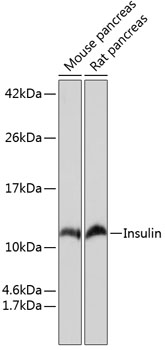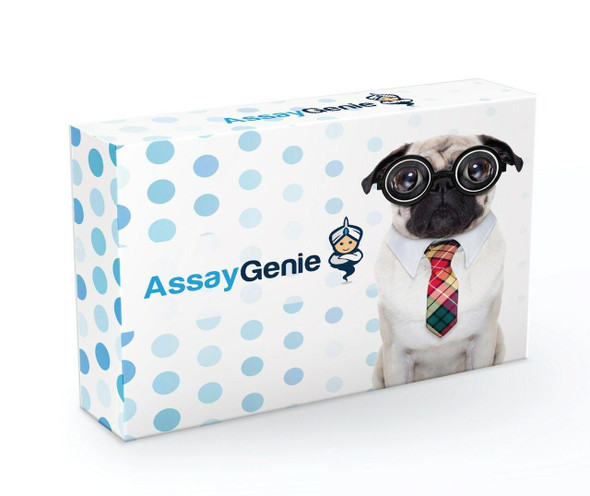Metabolism Antibodies 3
Anti-Insulin Antibody (CAB19066)
- SKU:
- CAB19066
- Product Type:
- Antibody
- Reactivity:
- Mouse
- Reactivity:
- Rat
- Host Species:
- Rabbit
- Isotype:
- IgG
- Research Area:
- Metabolism
Description
| Antibody Name: | Anti-Insulin Antibody |
| Antibody SKU: | CAB19066 |
| Antibody Size: | 20uL, 50uL, 100uL |
| Application: | WB IHC IF |
| Reactivity: | Mouse, Rat |
| Host Species: | Rabbit |
| Immunogen: | A synthesized peptide derived from human Insulin |
| Application: | WB IHC IF |
| Recommended Dilution: | WB 1:500 - 1:2000 IHC 1:50 - 1:200 IF 1:50 - 1:200 |
| Reactivity: | Mouse, Rat |
| Positive Samples: | Mouse pancreas, Rat pancreas |
| Immunogen: | A synthesized peptide derived from human Insulin |
| Purification Method: | Affinity purification |
| Storage Buffer: | Store at -20°C. Avoid freeze / thaw cycles. Buffer: PBS with 0.02% sodium azide, 0.05% BSA, 50% glycerol, pH7.3. |
| Isotype: | IgG |
| Sequence: | Email for sequence |
| Gene ID: | 3630 |
| Uniprot: | P01308 |
| Cellular Location: | |
| Calculated MW: | kDa |
| Observed MW: | 12kDa |
| Synonyms: | IDDM, IDDM1, IDDM2, ILPR, IRDN, MODY10, INS, Insulin, insulin |
| Background: | After removal of the precursor signal peptide, proinsulin is post-translationally cleaved into three peptides: the B chain and A chain peptides, which are covalently linked via two disulfide bonds to form insulin, and C-peptide. Binding of insulin to the insulin receptor (INSR) stimulates glucose uptake. A multitude of mutant alleles with phenotypic effects have been identified. There is a read-through gene, INS-IGF2, which overlaps with this gene at the 5' region and with the IGF2 gene at the 3' region. Alternative splicing results in multiple transcript variants. [provided by RefSeq, Jun 2010] |
| UniProt Protein Function: | Insulin: Insulin decreases blood glucose concentration. It increases cell permeability to monosaccharides, amino acids and fatty acids. It accelerates glycolysis, the pentose phosphate cycle, and glycogen synthesis in liver. Heterodimer of a B chain and an A chain linked by two disulfide bonds. Belongs to the insulin family. |
| UniProt Protein Details: | Protein type:Secreted; Secreted, signal peptide; Hormone Chromosomal Location of Human Ortholog: 11p15.5 Cellular Component: extracellular space; Golgi lumen; endoplasmic reticulum lumen; extracellular region Molecular Function:identical protein binding; insulin-like growth factor receptor binding; protein binding; protease binding; hormone activity; insulin receptor binding Biological Process: positive regulation of nitric oxide biosynthetic process; positive regulation of vasodilation; glucose homeostasis; activation of NF-kappaB transcription factor; positive regulation of glucose import; negative regulation of protein oligomerization; regulation of protein localization; cell-cell signaling; negative regulation of gluconeogenesis; acute-phase response; regulation of transmembrane transporter activity; negative regulation of NAD(P)H oxidase activity; positive regulation of mitosis; activation of protein kinase B; positive regulation of nitric-oxide synthase activity; negative regulation of acute inflammatory response; glucose metabolic process; positive regulation of lipid biosynthetic process; positive regulation of protein amino acid autophosphorylation; positive regulation of cell growth; positive regulation of phosphoinositide 3-kinase cascade; positive regulation of peptidyl-tyrosine phosphorylation; positive regulation of cell differentiation; negative regulation of protein catabolic process; regulation of amino acid metabolic process; negative regulation of glycogen catabolic process; wound healing; positive regulation of glycogen biosynthetic process; positive regulation of cellular protein metabolic process; glucose transport; regulation of protein secretion; negative regulation of lipid catabolic process; regulation of transcription, DNA-dependent; positive regulation of MAPKKK cascade; negative regulation of vasodilation; positive regulation of cell proliferation; negative regulation of proteolysis; negative regulation of protein secretion; MAPKKK cascade; negative regulation of fatty acid metabolic process; alpha-beta T cell activation; endocrine pancreas development; G-protein coupled receptor protein signaling pathway; positive regulation of protein kinase B signaling cascade; cellular protein metabolic process; fatty acid homeostasis; positive regulation of glycolysis; insulin receptor signaling pathway; energy reserve metabolic process; positive regulation of insulin receptor signaling pathway; regulation of insulin secretion; positive regulation of DNA replication; positive regulation of cytokine secretion; positive regulation of cell migration Disease: Diabetes Mellitus, Insulin-dependent, 2; Diabetes Mellitus, Permanent Neonatal; Hyperproinsulinemia; Maturity-onset Diabetes Of The Young, Type 10 |
| NCBI Summary: | After removal of the precursor signal peptide, proinsulin is post-translationally cleaved into three peptides: the B chain and A chain peptides, which are covalently linked via two disulfide bonds to form insulin, and C-peptide. Binding of insulin to the insulin receptor (INSR) stimulates glucose uptake. A multitude of mutant alleles with phenotypic effects have been identified. There is a read-through gene, INS-IGF2, which overlaps with this gene at the 5' region and with the IGF2 gene at the 3' region. Alternative splicing results in multiple transcript variants. [provided by RefSeq, Jun 2010] |
| UniProt Code: | P01308 |
| NCBI GenInfo Identifier: | 124617 |
| NCBI Gene ID: | 3630 |
| NCBI Accession: | P01308.1 |
| UniProt Secondary Accession: | P01308,Q5EEX2, |
| UniProt Related Accession: | P01308 |
| Molecular Weight: | 110 |
| NCBI Full Name: | Insulin |
| NCBI Synonym Full Names: | insulin |
| NCBI Official Symbol: | INS |
| NCBI Official Synonym Symbols: | IDDM; ILPR; IRDN; IDDM1; IDDM2; MODY10 |
| NCBI Protein Information: | insulin; proinsulin; preproinsulin |
| UniProt Protein Name: | Insulin |
| Protein Family: | Insulin |
| UniProt Gene Name: | INS |
| UniProt Entry Name: | INS_HUMAN |







